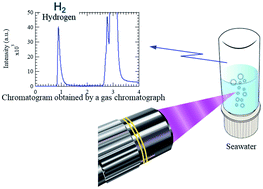Electrodeless hydrogen production from seawater using femtosecond laser pulses†
Abstract
This study presents the first experimental evidence of direct H2 production from seawater without harmful gas emissions (e.g., CO2, Cl2), which uses multiphoton ionization water splitting with a femtosecond pulse laser. According to H2 analysis using a gas chromatograph, the H2 production rate in seawater was 70 μmol h−1, which was approximately 3.3 times more than the ultrapure water case reported in the literature. This positive effect derives from focusing through the cuvette wall and the more significant Kerr effect in seawater. Such ion enhancement was observed in the case of seawater and diluted seawater compared with the ultrapure water case, but excessive salt can lead to ion suppression and adverse effects. These differences in salinity suggest appearances of nonlinear optical effects near the focal point and ionization of metallic elements with low ionization potential and are discussed in relation to results of bubble visualization, gas composition analysis, and pressure measurement in gaseous products.



 Please wait while we load your content...
Please wait while we load your content...